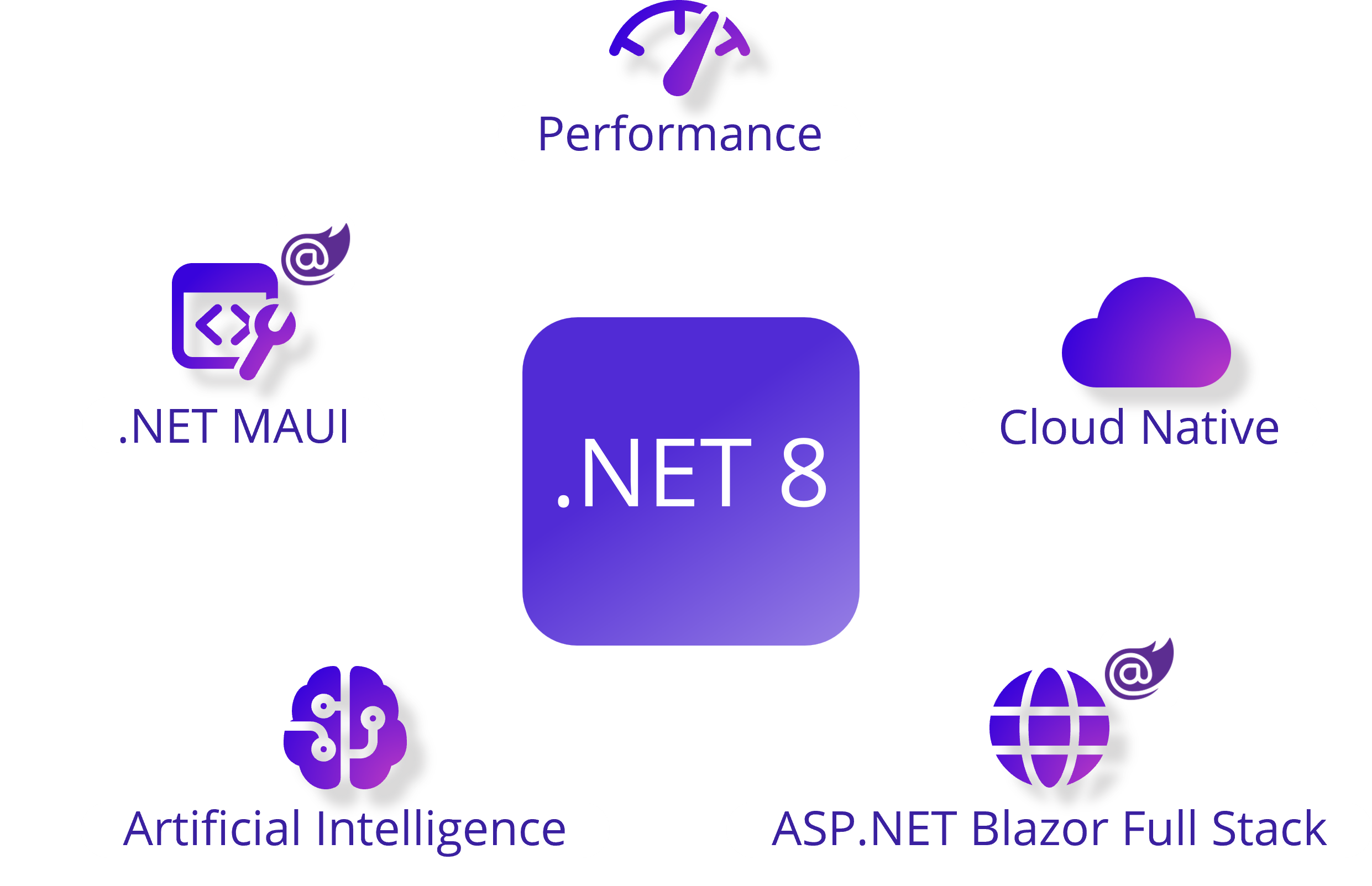To Upgrade .NET 6 to .NET 8 or Not: Is it Worth the Leap?
by DeeDee Walsh, on Jan 22, 2024 2:19:14 PM

Microsoft released .NET 8 in November 2023, and it was MASSIVE. The last long-term support (LTS) version of .NET - .NET 6 was equally earth-shattering. However, the differences between .NET 6 and .NET 8 are a bit like the first Tesla Roadster (which was amazing and revolutionary) and the current Tesla Model S. Both are great cars but the Model S is going to get you where you want to go. Similarly, .NET 6 is really, really solid but .NET 8 is even better. Let's compare and contrast .NET 6 and .NET 8.
.NET 6 was phenomenal
.NET 6, released in November 2021, was all about boosting performance and runtime. The idea was to make .NET applications faster and more resource-efficient. This version introduced several performance gains like improved Just-In-Time (JIT) compilation, better garbage collection, and optimizations in file I/O and string operations. It also brought in some language improvements like pattern-matching enhancements and file-scoped namespaces, which were quite a boon for developers. .NET 6 was more about unifying the .NET platform and pushing for overall performance improvements.
But .NET 8 is GREAT
On the other hand, .NET 8, which came out in November 2023, shifted its focus towards enhancing the developer experience. It introduced changes to existing pattern-matching, primary constructors, collection initializers, and significant improvements in support for generics. .NET 8 also added new features in C#, like record types and improved pattern matching, making it easier for developers to write clear and concise code. In terms of performance, .NET 8 stepped up with enhanced Native AOT compilation, better memory efficiency with generational garbage collection, and optimized performance for ASP.NET Core and .NET MAUI. It also introduced SHA-3 for better security, time abstraction, and support for new hardware like Vector512 and AVX-512.
When it comes to observability, .NET 6 relied more on third-party tools like OpenTelemetry, whereas .NET 8 built-in tools and features for observability. This makes monitoring and troubleshooting a bit more integrated with the newer version.
But I feel like I'm underselling .NET 8 because there are some AWESOME features and upgrades that make it orders of magnitude better. My two favorite features of .NET 8 are .NET Aspire and all the new stuff in Blazor:
- .NET Aspire: TL;DR it's a toolset to make building cloud-native .NET applications easier. Technologies like containers are complex, and .NET Aspire makes it easy! Longer description: it's an opinionated, cloud-ready stack designed for building, managing, and observing production-ready, distributed applications. This stack simplifies app development, focuses on cloud-native capabilities, and is equipped with a variety of tools and services. Aspire aids in orchestrating complex applications, ensuring seamless integration and efficient deployment in cloud environments, notably Azure. With features like built-in telemetry, logging, and support for containerization, Aspire streamlines the development process, catering specifically to modern distributed applications.
- Blazor 8: This update represents a significant leap forward in web development, offering features that are directly beneficial to you. Its versatility in rendering modes — from static server to interactive WebAssembly — means you can build a wide range of applications, from fast-loading SEO-friendly sites to complex, interactive web apps. The efficiency brought by performance improvements like Jiterpreter and AOT enhancements ensures your applications are not just powerful, but also performant and responsive, providing an exceptional user experience. Its innovative features, like the unified Blazor Web App template and enhanced form handling, simplify the development process, allowing you to focus on creating rather than configuring. User-friendliness is at the core of Blazor 8, with awesome documentation and streamlined APIs, making it easier for you to adopt and master these new capabilities. Blazor 8 is more than just a framework update; it's a toolset that jumpstarts the development of modern, efficient, and high-quality web apps.
Let's talk about how to migrate from .NET 6 to .NET 8.
First up, you'll want to deck out your dev environment with .NET 8. Hit up the official .NET website, grab the installer, and get that sorted. Next, dive into your project file. You're looking to tweak the target framework to .NET 8. Think of it like reconfiguring your dev toolkit for the new landscape.
Now, roll up your sleeves for the real engineering bit. It's time to scrutinize those NuGet packages. Some might be relics from the .NET 6 era, so you'll need to bring them up to speed. This part's crucial - outdated packages can throw a wrench in the works faster than you can say "build error."
After you've done the updates, it's testing time. Fire up your application and watch for any surprises. Runtime errors? Compile-time hiccups? Squash them as they come. This is where your geek problem-solving skills really shine.
And, of course, the golden rule - test everything. Unit tests, integration tests, you name it. Treat it like a thorough stress test for your newly upgraded application. You're aiming for a smooth ride in the .NET 8 landscape, so leave no stone unturned.
Remember, migrations like this aren't always a straight line. You'll need to make a few extra tweaks specific to your project. But hey, that's part of the fun, right? Which leads me to the next issue...
Adapting to .NET 8: Navigating Breaking Changes
So now let's get to the hard stuff with moving to .NET 8. It's got a mix of breaking changes. We're looking at tweaks in ASP.NET Core, some updates in the Cryptography space, and a few shifts in the Core .NET libraries. What this means is that hopping onto .NET 8 could need some code juggling. You might have to wave goodbye to some old methods, get your head around the new API behaviors, and brush up on the latest in security. It's criticalto check out these changes closely to avoid any surprises in your projects. You can get the gritty details right here.
Embracing the Future with .NET 8
.NET 8 isn't just an upgrade; it's a HUGE leap forward in the .NET ecosystem. For developers, the introduction of .NET Aspire and the new features in Blazor 8 offer a more streamlined, efficient, and intuitive development experience. These improvements are not just about writing less code; they're about writing better code. The built-in observability tools, enhanced security features, and performance optimizations ensure that developers can build applications that are not only robust and secure but also easier to maintain and monitor.
For businesses, the decision to upgrade to .NET 8 should be a no-brainer. Better performance and efficiency mean faster, more reliable applications, which translates to improved user experience and lower operational costs. The focus on cloud-native capabilities with .NET Aspire aligns perfectly with the ongoing shift towards cloud environments, making .NET 8 a future-proof choice for organizations looking to stay competitive.
Lastly, for end-users, the benefits of .NET 8 might not be as obvious, but they are impactful. End users will get more responsive and secure applications, whether they're using a web app built with Blazor 8 or a desktop application powered by the latest .NET framework. The improvements under the hood provide a smoother and more enjoyable user experience across the board.
While upgrading to .NET 8 requires some initial effort in terms of adapting to breaking changes, the long-term benefits far outweigh the challenges. Whether you're a developer looking to use the latest technologies, a business looking to optimize your digital assets, or an end-user expecting high-performing applications, .NET 8 brings it. So, is .NET 8 worth the leap from .NET 6? Absolutely.



